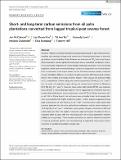Short- and long-term carbon emissions from oil palm plantations converted from logged tropical peat swamp forest
Abstract
Need for regional economic development and global demand for agro‐industrial commodities has resulted in large‐scale conversion of forested landscapes to industrial agriculture across South East Asia. However, net emissions of CO2 from tropical peatland conversions may be significant and remain poorly quantified, resulting in controversy around the magnitude of carbon release following conversion. Here we present long term, whole ecosystem monitoring of carbon exchange from two oil palm plantations on converted tropical peat swamp forest. Our sites compare a newly converted oil palm plantation (OPnew) to a mature oil palm plantation (OPmature) and combine them in the context of existing emission factors. Mean annual net emission (NEE) of CO2 measured at OPnew during the conversion period (137.8 Mg CO2 ha‐1 yr ‐1) were an order of magnitude lower during the measurement period at OPmature (17.5 Mg CO2 ha‐1 yr‐1). However, mean water table depth (WTD) was shallower (0.26 m) than a typical drainage target of 0.6 m suggesting our emissions may be a conservative estimate for mature plantations, mean WTD at OPnew was more typical at 0.54 m. Reductions in net emissions were primarily driven by increasing biomass accumulation into highly productive palms. Further analysis suggested annual peat carbon losses of 24.9 Mg CO2‐C ha‐1 yr‐1 over the first 6 years, lower than previous estimates for this early period from subsidence studies, losses reduced to 12.8 Mg CO2‐C ha‐1 yr‐1 in the later, mature phase. Despite reductions in NEE and carbon loss over time, the system remained a large net source of carbon to the atmosphere after 12 years with the remaining 8 years of a typical plantation’s rotation unlikely to recoup losses. These results emphasise the need for effective protection of tropical peatlands globally and strengthening of legislative enforcement where moratoria on peatland conversion already exist.
Citation
McCalmont , J , Kho , L K , Teh , Y A , Lewis , K , Chocholek , M , Rumpang , E & Hill , T 2021 , ' Short- and long-term carbon emissions from oil palm plantations converted from logged tropical peat swamp forest ' , Global Change Biology , vol. Early View . https://doi.org/10.1111/gcb.15544
Publication
Global Change Biology
Status
Peer reviewed
ISSN
1354-1013Type
Journal article
Description
Funding: The research was carried out as part of a project funded by the Malaysian Palm Oil Board (MPOB). L. K. K and E. R. are both employees of MPOB. The research was carried out with the support of Sarawak Oil Palm Berhard (SOPB) on whose land the research project was based.Collections
Items in the St Andrews Research Repository are protected by copyright, with all rights reserved, unless otherwise indicated.

